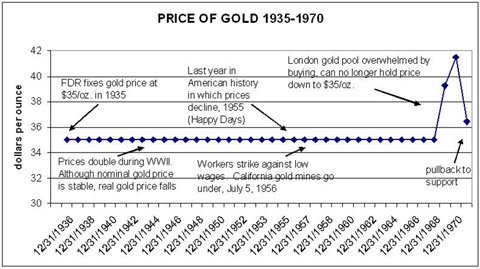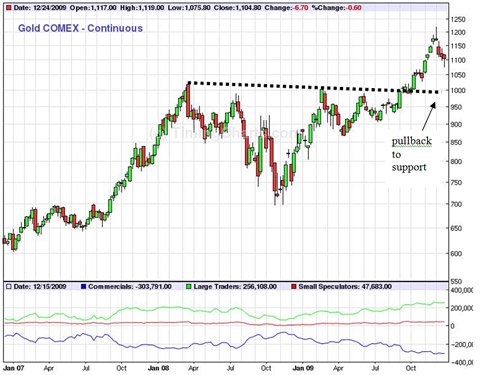
TRUMP SAYS: HUNTER MAKES FORTUNE FROM SHADY DEALS!
BIDEN FAMILY STINKS TO HIGH HEAVENS OF CORRUPTION!
DON'T GET LEFT OUT: HUNTER MUST BE STOPPED!

Today we stand on the threshold of one of the great moves in financial history. The signal comes as what is called a pullback to support. It will be my goal in this article to convey to you the immense power of such a formation. So simple, yet fraught with such potential for profit.
The best way to understand pullback to support is to go back in history and see where it has happened before. In this regard, we are very fortunate because the all-time greatest buy point in gold, in the summer of 1970, occurred as a pullback to support. This is depicted in the chart above. The price of gold was set at $35/oz. in 1935 (by the U.S. Government) and remained exactly the same for 32 years. Then in 1968 it broke out to the upside.
But despite this calm exterior gold was beset with powerful forces beneath the surface. When FDR set gold at $35/oz. in 1935, this was too high. Gold had been $20.67/oz in 1932, and it would have taken a general price increase of 70% among all goods to justify this price for gold. Thus the late 1930s were a profitable time for the gold mines as their product was over valued.
However, during WWII the Government closed all the gold mines for the duration of the war. The fact that the American gold standard had created the greatest economy in the world did not penetrate the minds of the “brain trust†of that day. Fortunately for America all other countries were more anti-gold and had worse economies. Thus American armies had better equipment/technology and with general Patton in the van rolled over the opposition.
But over the course of WWII, prices in the U.S. more than doubled. The $35 price, which had been too high, now became too low. So although the gold mines were allowed to reopen after the war, they were forced to sell their product which was now too low. They struggled along, unable to pay their workers a competitive wage through the late ‘40s and early ‘50s, and in 1956 there was a general strike among the workers at the California gold mines. The mines could not meet the workers’ (quite reasonable) demands and were forced to close. These mines remain closed to this day.
As the (fixed) price of gold got more and more out of line with reality, the law of supply and demand came into play. At the (now very low) price of $35/oz, the gold mines had cut supply, and the world jewelry industry had increased demand. The U.S. alone could not shoulder the entire burden of suppressing the price of gold and, in 1962, recruited 9 other nations to form the London Gold Pool, which now took over the job of suppressing the price.
In 1968, the London Gold Pool was broken by the tremendous demand for gold which had built up. The price of gold shot up in what was the buying opportunity of the century.
Furthermore, it was easy to see. First, after being stable for over 30 years, when gold did break out, it broke out upside, not downside. Thus demand must have been stronger than supply. Second, the supply had been the greatest in world history. Ten nations used all their power to keep gold down and this enormous supply had been overwhelmed. Third, a little fourth grade mathematics cast a great deal of light on the situation. Gold had been $20.67 for the better part of 145 years. Since 1933, average prices in the U.S. had tripled (implying a gold price of $62/oz). Further, the political situation presaged much greater issues of paper money in the not-too-distant future. That was the time when Richard Nixon announced, “I am a Keynesian.†With both Republicans and Democrats now anti-gold, the way was clear for massive issues of paper money and a massive increase in prices. This was what in fact occurred, and it was not hard to see at the time.
However, all of the authority figures of the day denounced gold as a speculation and sneered at the idea that gold would go up in price. Most well known was the statement, at that time, by Henry Reuss, Chairman of the House Banking Committee, that gold was going to decline to $6 or $8 per ounce. These were the people who were running the country at the time, (and the people who are running it today are 10 times worse).
`Next, in our little story, it is necessary to understand something about technical analysis. The fundamental analyst predicts prices by studying the fundamental factors, factors which influence supply and demand. The technical analyst studies factors which pertain to the market itself (such as price, volume or other properties of the markets) Traditionally the fundamentalist was more interested in why a good should go up, and the technical analyst was more interested in whether a good would go up. If both proved wrong, the fundamentalist would say, “In the long run I have to be right because the fundamentals will out.†The technician would say, “I am going to cut my losses short. I am outta here.†To put it another way, the fundamentalist asked why; the technician asked how far?
For this reason the fundamentalist is easier to understand, and the technician does not connect with most people, even though he is right more often. For this reason almost all brokerage houses are fundamentalist because they have to appeal to the general public and don’t really care whether their customers make money (although they will never admit this).
However, my explanation of many technical formations in terms of Thomas Aquinas’ theory of the fair price takes technical analysis out of the realm of pragmatism and explains why it works. Over the last millennium, there have been two famous teachers of economics, Adam Smith and Thomas Aquinas. Aquinas said that every good had a fair price and ought to trade at its fair price. But Adam Smith pointed out that Aquinas’ fair price was not properly defined. Aquinas said that the fair price was that price which enabled the merchant (who sold the good) to make a living appropriate to his standing in the community.
Of course, community standards simply come from that to which people have become accustomed. In one community, where people have become accustomed to a high price (due to an aggressive merchant), they will think the high price fair. In another community, where people have become accustomed to a low price (due to an economical merchant), they will think the low price fair. There is, therefore, no agreement, even among believers in the fair price theory, as to how one actually computes the fair price.
Smith, therefore, argued that there is no such thing as a fair price, and the only price which is ethical is the price agreed upon by both buyer and seller.
This is the state of affairs today, and the followers of Thomas Aquinas and the followers of Adam Smith do battle in the world’s markets. However, since Smith is right and Aquinas wrong, it is the followers of Smith who have the advantage and can win out in the contest for profits.

Remember, what the believer in the fair price theory says is that the price to which he is accustomed is the price which is fair. What did gold traders think in 1968-69? Gold had been $35. Now it was $40. To them, the fair price was $35, and they concluded that gold was too high. Since it was too high, it had to come down, and they sold it off to $35 again (in 1970). This is why, in defiance of the fundamentals, gold came down in 1970. A technician would say that gold had been drawn to its support level (of $35) after its breakout.
Think about it. There are only a small number of people who understand and follow Adam Smith. But the number of people who follow Aquinas and commit the fallacy of believing in the fair price is very large. Not only are the fair price people wrong. They are wrong in such a manner that their actions can be predicted by technical analysis.
Now the good fundamentalist will reply: “In the long run, the fundamentals will win out.†This is true, but there are two problems with it. It is very hard to get the fundamentals right. And if you do, then you can still be very wrong in the short terms. Suppose you are a brilliant fundamental analyst. You see the internet stocks on the NASDAQ going berserk in 1999. You know that, having a P:E ratio of infinity, they are very much overvalued. So you sell them short. Then they multiply by ten times, and your broker says, “More margin, please.†There you are. Right and broke. That can’t happen to a technician because he knows where to place a stop loss order. He will take losses, but he will stop them before they get too big. He will live to fight another day.
Look at the weekly gold chart of 2007-2009. Notice the resemblance to the annual chart of 1935-1970. In both cases, we have a flat line ($35 in the annual chart, $1,000 in the weekly chart). Then the market breaks to the upside and then makes a return to the line, what the technician calls a return to support. When the good moves noticeably above the line, many people regret not having bought at that level and resolve to do so if the opportunity should present itself. All these potential buyers represent what the technician calls support.
So here we are at the end of 2009, and the gold market faces the exact same situation as it did in the summer of 1970. Gold has broken out above a flat line and moved into new all-time high ground. Then it has started to pull back. We know what will happen. (The followers of) Adam Smith will win. (The followers of) Thomas Aquinas will lose. It’s been happening that way for a long, long time.
The purpose of market speculation is to beat the other guy, and in order to do that one must know what the other guy is going to do before he does it. To understand that, one must know what the other guy is thinking, or will think tomorrow. Fundamental analysis only does that in a small percentage of the cases. Technical analysis started with the question, what works? It works because it gets inside the other fellow’s head and knows what he is thinking. I am not by any means an unreserved fan of technical analysis. Much of it consists of a group of intellectuals who are simply trying to show off their knowledge of mathematics and who use complicated techniques simply because they can. Fibonacci’s series, for example, works when it works but is not reliable enough to give one consistent profits. But no one has ever shown that Fibonacci’s series allows one to get inside the other fellow’s head.
But the bottom line is that we are now close to one of the great buying opportunities of history. The big money is made in the big move. And here at the end of 2009 we are in a replay of the great buy opportunity of the summer of 1970. This is your chance of a decade.
I am the editor/publisher of the One-handed Economist, a financial letter which combines fundamental and technical analysis. I was a bug on gold in the 1970s and became a bug on gold again in late 2002. You can subscribe to OHE for the modest price of $300/year, and to do so please visit my web site, www.thegoldspeculator.com. You may also want to visit my blog, www.thegoldspeculator.blogspot.com. This week’s blog is an Open Letter to Congressman Ron Paul and Sen. Bernie Sanders on the subject of socialized medicine. It is guaranteed to get you mad (hopefully with me, not against me), and it will help give you the big picture about the world in which we live. Thank you for your interest.
# # #

It Took 22 Years to Get to This Point
Bird flu has been detected in mammals on the Texas panhandle, including skunks, raccoons, and...
This article was originally published by Tyler Durden at ZeroHedge. A top Russian general has...
The public's ignorance about food safety and vaccination is now a hindrance to the prevention of...
This article was originally published by Willow Tohi at Natural News. Trump’s 10% tariffs on...
Commenting Policy:
Some comments on this web site are automatically moderated through our Spam protection systems. Please be patient if your comment isn’t immediately available. We’re not trying to censor you, the system just wants to make sure you’re not a robot posting random spam.
This website thrives because of its community. While we support lively debates and understand that people get excited, frustrated or angry at times, we ask that the conversation remain civil. Racism, to include any religious affiliation, will not be tolerated on this site, including the disparagement of people in the comments section.


Comments